
- Big battery life
- Improved mapping features
- Same great core sports tracking
- Big case won't be for everyone
- Heart rate accuracy during high intensity
- So expensive
Garmin has unleashed its Fenix 7 series watches promising big changes from its Fenix 6 series as it seeks to cement its placs as the top outdoor watch pick.
Across the board, Garmin is promising an upgraded Fenix experience adding new features to make outdoor tracking more accurate, improving the mapping experience, especially for winter sports lovers, along with new cycling and running-focused features.
Garmin has boosted battery life too in a big way, so the Fenix is much closer to its Garmin Enduro powerhouse.
The Garmin Fenix 7X is the biggest watch in the Fenix 7 range, offering the longest battery life, solar charging and the biggest screen.
We've been putting the 7X Sapphire Solar edition to the test, which offers the biggest battery life and screen in the range and some extras too. Here's our comprehensive verdict.
Garmin Fenix 7: Models and pricing
To cause great confusion to anyone that's eyeing up a Fenix 7 series watch, there's a quite frankly ridiculous number of models to choose from, which all bring a different mix of looks, finishes, features and pricing. Here's the breakdown:
- Fenix 7S: $699/£599 (read our full Fenix 7S review)
- Fenix 7S Solar: $799/£689
- Fenix 7S Sapphire Solar: $899/£779
- Fenix 7: $699/£599 (read our full Fenix 7 review)
- Fenix 7 Solar: $799/£689
- Fenix 7 Sapphire Solar: $899/£779
- Fenix 7X Solar: $899/£799
- Fenix 7X Sapphire Solar: $999 and £1,049
There's also the Garmin Epix at $899/$799, which is essentially a Fenix with an AMOLED screen. You can read our Epix vs Fenix comparison guide to help you choose.
Obvious Fenix alternatives are the Coros Vertix 2 ($699/£599) with its 140 hour GPS battery life, and the Polar Grit X Pro ($429/£379).
Garmin Fenix 7X: Design and touchscreen

The Fenix 7X, just like the Fenix 6X, is a hulking watch. If you like your outdoor watches big and rugged, then you're well catered for here.
We can't imagine too many women opting for the 51mm case, which tips the scales close to 100g.
We had the Garmin Fenix 7X Sapphire Solar to test, which features a titanium DLC bezel compared to the stainless steel on on the standard 7X Solar. That helps drop the weight to 89g, compared to the 96g on the 7X Solar.
The screen is still a 1.4-inch, 280 x 280 resolution transflective display – so there hasn't been any visual improvement in the screen technology between the Fenix 6 and Fenix 7 range. However it is now a touchscreen, which works in addition to the familiar five physical buttons.
This is the first time we've seen Garmin add touch to the Fenix range, and the good news is that it's well executed on the whole.
The screen is nicely responsive to touch, with no detectable lag – and it does work well on the whole.
Being seasoned Fenix users we still opted for the buttons in most instances, but it means you get more of a smartwatch feel here now, letting you swipe up and down from the main watch face or through activities in the workout tracking screen.
It does also work with mapping, letting you swipe through maps rather than use the baffling button controls – but that functionality is turned off as default, so you'll need to enable it if you want to use it.
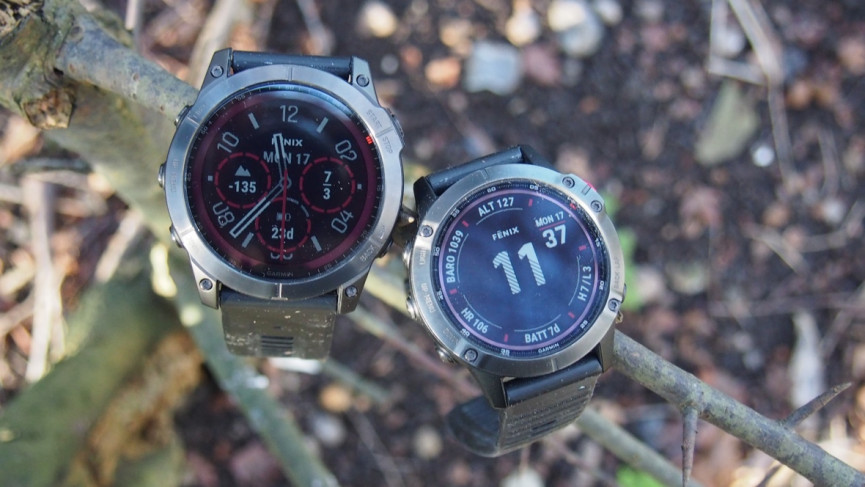
Fenix 7X (left) and Fenix 6 Pro (right)
That screen remains a transflective one, which has become the display tech standard for Garmin outside of its Venu series and its new Epix watch. It means you get strong viewing angles indoors and outdoors in bright light and we found it well suited to viewing real-time stats in the water during swims as well.
There's the Power Sapphire lens on this edition, which gives you solar charging powers to boost battery life, and it's more durable than the standard Power Glass lens used on the 7X Solar.
We can't really say that Power Sapphire lens really made a notable different on our experience living with it, but if you're out trekking or hiking with it and want that bit of added protection, this is the one to buy.
In terms of waterproofing, you're getting something with a 10ATM rating matching the Fenix 6X in letting you submerge it in water up to 100 metres depth.
Fenix 7X: Flashlight

There's a backlight to improve nighttime viewing, and as a Fenix 7X exclusive, there's a built-in LED flashlight. Yes, we said a flashlight – this is not a drill.
This isn't just a feature that lights up the screen so you can use it like a torch, there's an LED light at the top of the watch that can be illuminated in a white light with four brightness levels.
There's also a red LED light, which we imagine could be used to signal if you've got lost for example. It's also incorporated into the workout tracking too, letting you switch it on and turn on cadence or blitz lighting modes to give you a visibility boost. It's not giving you a level of brightness that's going to replace a head torch, but it's a nice bonus hit of illumination to improve your visibility on nighttime jaunts near busy roads or when you're in the middle of nowhere.
Overall, it's an excellently built sports watch – if you like things bulky. It's not the nicest to take to bed to track sleep, but the titanium case definitely helps make that hulking frame is more manageable day-to-day and during tracking. And we loved the flashlight as a safety feature, too.
Garmin Fenix 7X: Software and smartwatch features

The addition of a touchscreen on the Fenix 7 series seems to be a clear move by Garmin to make its Fenix series watches feel more like a smartwatch.
And the Fenix does a good job of offering the kind of functionality you'd expect from an Apple Watch or a Samsung Galaxy Watch.
Those watches and others will still offer more in this department, but what does make the cut works well overall.
The Android and iOS-friendly watch lets you view notifications and respond to some notifications with Android phones. And there's Garmin Pay for contactless payment support, if you're with one of the banks that's supported.
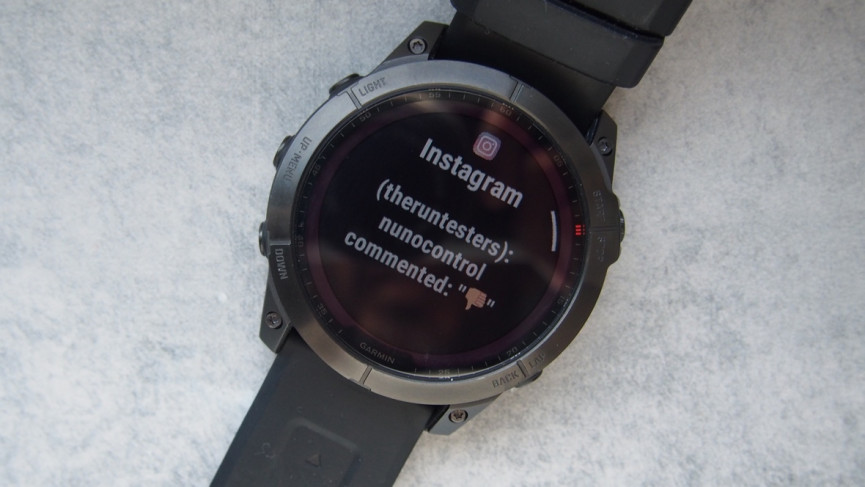
There's a built-in music player with support for offline playlist syncing via Wi-Fi with Spotify, Deezer or Amazon Music.
We tried it out with Spotify and found that pairing up headphones feels quicker than previous Garmins, which is nice to see.
The experience does feel a little clunky in places, particularly with controls, but now that you have a touchscreen in play, it's much nicer to skip tracks or turn up the volume.
Speaking of clunky, the 7X does have access to Garmin's Connect IQ store to grab watch faces, data fields and apps. The process of getting those apps is still a bit slow going and the process of getting something installed and synced to the watch doesn't always feel seamless as it should be on most occasions.
The on-watch software experience is as good as it's ever been on a Fenix, and you now have a touchscreen to make it easier to get around.
You can dig deeper for more settings, but you'll likely be spending most of the time in the customizable Glances screen and maybe delving into circular quick settings screen.
That makes the Fenix 7X feel less daunting to use, but also serves more demanding users if they want to further tweak settings.
Garmin Fenix 7X: Sports tracking and heart rate accuracy
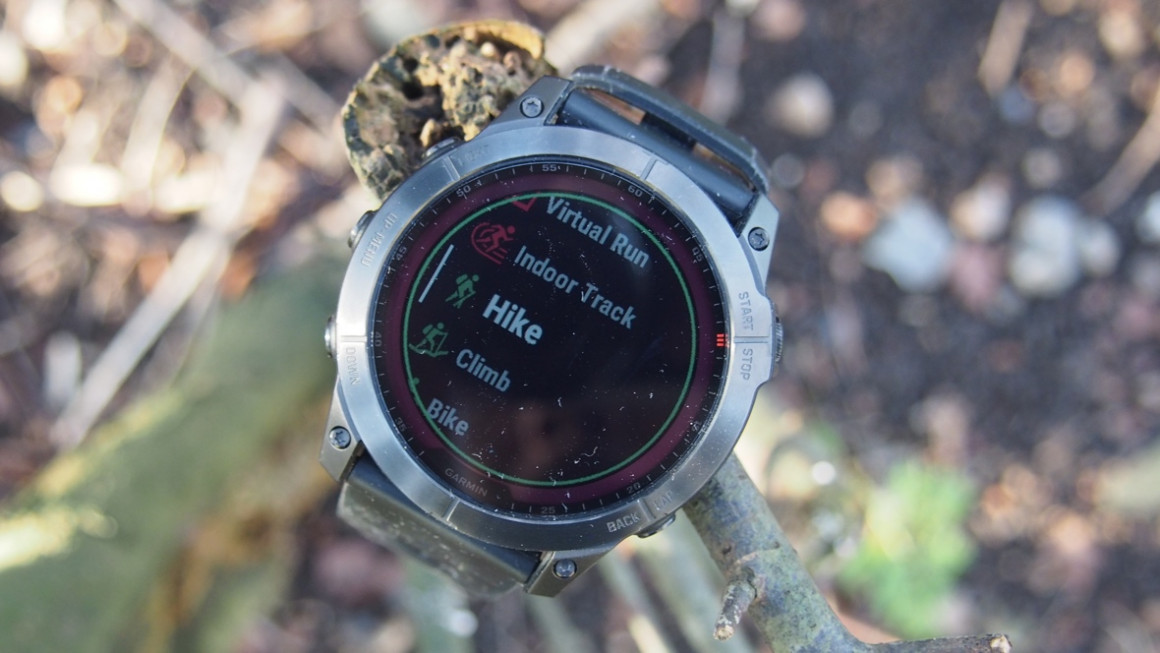
Historically, the Fenix has been a complete outdoor companion, with maps, sports modes with rich outdoor-centric metrics, and more recently, safety features for solo adventuring.
The 7X is packed to the rafters with sensors including everything that was present in the 6X.
All the key sensors are on board here, including Garmin's ABC sensors (altimeter, barometer and compass).
There's Garmin's latest Gen 4 Elevate optical heart rate sensor technology to monitor heart rate continuously, during workouts and to fuel analysis features and wellness ones like stress monitoring and respiration tracking during yoga and Pilates workouts. That's an upgrade on the Gen 3 Elevate sensor featured on the Fenix 6 series.
There's also Garmin's Pulse Ox sensor to track blood oxygen levels during sleep or continuously, though turning it on will have a noticeable drain on battery life.
Multi-band GNSS support
One of the big new features here is the addition of multi-band GNSS support, which offers a huge boost to GPS accuracy.
All Fenix 7 editions use GNSS, which offers wide support for all the different satellite systems (GPS, Glonass, and Galileo) which means a faster lock on and a more reliable connection. It also enables you to use All Systems GPS connectivity, which partners good old GPS with one of the others.
All Systems does have an impact on battery life – but can help when you're on routes in built up areas or with tree cover.
But if you're really looking for tip-top accuracy, the new multi-band GNSS technology takes things further. It's only available on Sapphire Solar editions of the Fenix 7 series, and enables the sports watch to lock onto L1, L2 and the newer L5 satellite frequencies, for improved accuracy.
It's not the first watch to do it, with the Coros Vertix 2 offering the functionality before Garmin.
At first glance, we didn't feel there was a huge difference between the Fenix 7X using multi-band GNSS against the Fenix 6. But a closer look at the routes show a nice improvement on tracking (see below).

GPS tracking compared: Fenix 7X (left) and Fenix 6 Pro (right)
That's accuracy everyone can benefit from, and a big reason to plump for the Fenix 7X.
It's easy to enable too as you'll just need to dig into your pre-workout settings to switch it on if you need that extra accuracy boost.
In typical Fenix fashion, there's no shortage of sports profiles at your disposal, whether you stick to the core ones like running, cycling and swimming or need something for more niche pursuits.
Those profiles include trail running, swimming (pool and open water), biking, hiking, rowing, skiing, golfing, surfing and indoor climbing. Basically, there's a lot and you're getting activity-specific metrics, like skiing dynamics, if you spend your exercise time mostly surrounded by snow.
Running, Swimming and HIIT

If you're turning to the 7X for running, then isn't a shortage of features here and additional metrics and analysis you can lean on.
It's compatible with Garmin Coach to follow personalised training plans on the watch and you can use the very impressive PacePro pacing strategies to better strategise for races.
You still get daily suggested workouts that definitely felt like a feature more geared towards less experienced runners, but does offer some good guidance on the type of running sessions you can do, if you're starting to add more structure to your running.

Run tracking compared: Fenix 7X (left) and Fenix 6 Pro (right)
Garmin's has included the improved recovery advisor it introduced on the Garmin Forerunner 745, but has since rolled to other Garmin watches too. It felt nicely in tune when after we tackled a tough day of exercise.
If you love looking at your predictions for a particular race distance, Garmin has added trend graphs to help you better understand what's driving those trends. It's the kind of context that's been needed to better understand whether you're progressing – or a kick up the backside if not.

Outside of run tracking, we also spent some pool swimming time with the Fenix 7X. It's is a big watch to take into the water, but it held up well on the accuracy front and offers a good a swim tracking experience you'll find on a Garmin and other sports watches.
There's all the usual metrics to view in real-time and in the Connect app post-swim and you can dive into the Connect IQ Store to add more value and data fields to your swim time.
Garmin has also brought over animated workouts and the HIIT workout mode from its Venu series watches.
That means you can track freestyle or opt for a guided session with automatic rep counting built into those workouts. It also offers an Every Minute On the Minute (EMOM) timer and As Many Round as Possible (AMRAP) workouts to better cater for HIIT fans.
Like a lot of Garmin's more gym-focused workout modes, it's still not the most seamless and intuitive feature, but if you want something that offers more features for HIIT, that's what the 7X can and does offer.
The Fenix 7X is a bit of sports tracking powerhouse. For core and more outdoorsy sports, it will serve most well.
Runners and cyclists will get a lot from them too, more so with that GNSS support and improved virtual race predictor and intriguing Stamina metric. There's a lot here and whether you're fitness newcomer or a pro, you should be happy with what you find here.
Stamina

On the training metrics front, you can still delve into your VO2 Max and like the Fenix 6X, you're able to see things like training status, effect, load as well as heat and altitude acclimation insights.
For the Fenix 7 Garmin has added Stamina tracking into the mix. It's primarily designed for runners, but should be applicable for other activities.
Stamina aims you a better insight into your exertion during a run. It uses your data to estimate how far you should be able to run, which sounds like an impressive concept.
It looks at a range of information such as heart rate and pace to estimate what you have in the tank. Think of it a bit like Garmin's Body Battery energy monitor but applied specifically to exercise time.
During a workout, there's a dedicated Stamina data screen, which displays two stamina percentages.
One is actual stamina and the other is potential stamina. The potential stamina percentage is based on the total capacity of your tank and it will decrease more rapidly if you're running at a high effort level.
Actual stamina is a measurement of much stamina you will have left based on your current effort level.
There's also a bar on screen that changes colour based on whether you're losing stamina, maintaining it or recharging it.

Stamina data displayed in Garmin Connect
We put it to the test on a pre-planned 10 mile run at our usual race pace, where we began with 100% stamina and potential stamina percentages.
Going out hard, the stamina levels were in the red and dropping very quickly. When we slowed up the pace, it went back to green.
Before the end of the 10 miles it had hit 0% stamina a couple of miles out from our planned 10 miles. We still felt like we had miles in the tank, but it did kind of represent the level of mileage were were up to based on most recent training runs.
Looking at the numbers itself in real-time, it didn't feel clear what we were meant to do with that information as it fluctuated.
It dropped quicker when we ran faster and stabilised when we slowed up a little. Most of our runs are planned on exertion level – so we didn't find the idea of slowing up too useful.
In the Connect app, you can get a sense of where those stamina levels dropped. It feels like it could potentially be useful to help make sure you're not going out too quick in a long race – perhaps a marathon distance – or for long training runs to make sure you cover the mileage your body is supposedly up to the task to tackle.
It clearly needs a lot of historical data to better understand your stamina levels and how far you might you might be able to go without blowing up.
It also suggests that you've sufficiently loaded with carbohydrates to prior to using it, but doesn't specify the level or amount.
Ultimately, it feels like a feature that's a work in progress, and we'd like it to work better with existing tools like PacePro in the future.
Fenix 7X: Heart rate monitor accuracy

Of course there's a heart rate monitor on board for all-days health tracking, and for keeping tabs on your body during workouts.
Garmin adds its latest Gen 4 Elevate sensor technology, it serves up a lot of the same problems we've experienced before with optical sensors.
For steady paced runs or stationary indoor rowing workouts for instance, heart rate monitoring averages, maximum heart rate readings and heart rate graphs were pretty reliable.
As soon as we picked up the pace for intervals and track sessions, we started to see some erratically high maximum heart rate readings compared to a Wahoo Tickr X chest strap monitor.

Heart rate tracking compared: Garmin Fenix 7X (left) and Wahoo Tickr X chest strap monitor (right)
There's Bluetooth and ANT+ connectivity here, so you can pair up a chest strap monitor and that's what we'd suggest you do if you care about training by heart rate and making the most of all of its other heart rate-based insights.
Garmin Fenix 7X: Fitness tracking and wellness tracking

For those who care more about steps, monitoring sleep or logging how much water you drink daily, the 7X serves up those fitness tracking and wellness features too.
All of Garmin's key activity tracking features are here, including adaptive step counts goals and the Move Bar to make sure you're staying active during the day and it will track floors climbed.
There's automatic sleep monitoring, where you'll see a breakdown of sleep stages including REM sleep. The dedicated watch widget will give you a snapshot of your most recent sleep too.
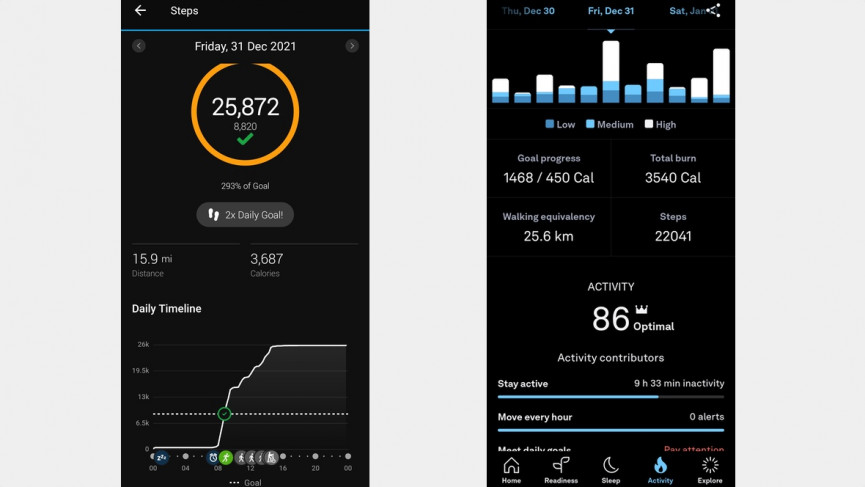
Step tracking compared: Garmin Fenix 7X (left) and Oura Ring 3 (right)
On the accuracy front though, the Fenix 7X like a lot of Garmins feels a bit over generous recording sleep duration recognising time in bed as sleep time.
It's nicely presented in the Garmin Connect app and on the watch. If you want the best in sleep tracking though, there's other watches that will do a better job of it.

Sleep tracking compared: Fenix 7X (left and centre) and Oura Ring 3 (right)
The heart rate monitor on board the Fenix 7X can deliver continuous heart rate monitoring, which we felt in general was reliable on the whole and despite the hulking size of the 7X it did deliver resting heart rate data on par with what we saw from a Fitbit Charge 5 and Oura Ring 3.
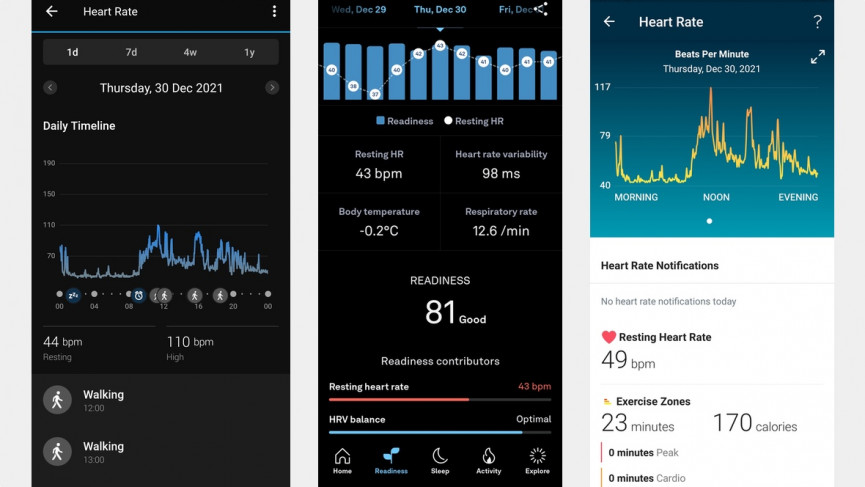
Continuous HR compared: Fenix 7X (left), Oura Ring 3 (centre) and Fitbit Charge 5 (right)
That might be tied to the size of the 7X as generally Garmin's newer watches perform well on the continuous heart rate monitoring front.
On the health and wellness front, Garmin doesn't promise that it can detect serious health conditions, but it does offer some features and insights that will try to give you a better sense of your current wellbeing.
The health snapshot feature, grabbed from the Garmin Venu 2, lets you see heart rate, stress, respiration rate and blood oxygen levels from a two-minute measurement.
Garmin's Body Battery energy monitoring feature feels a little more useful seeking to tell you when you should rest up by looking at heart rate variability, stress and sleep among other data.
Again, the reliability of these kinds of features is hugely reliant on the optical sensor being accurate and getting reliable sleep tracking, which wasn't always the case. It's an easy to understand feature and one you can apply to your daily life simply, but more as a guidance on your decision about whether to hit it hard in the gym or consider taking a rest day.
Garmin Fenix 7X: Mapping and navigation

Mapping is likely a reason you'll be looking at the Fenix 7X (or any of the Fenix 7 series) and it's one of the few outdoors watches that can deliver mapping from the wrist.
And things have improved on the Fenix 7X.
You get full colour maps, including dedicated maps for golf courses, and all-new Skiview maps to view run names and difficulty ratings of runs before you choose to tackle them.
You can download Topoactive maps, with the Sapphire Solar Edition preloaded with local region Topo maps, which is another big upgrade from the Fenix 6.
Those maps offer the same rich detail, letting you see terrain contours, elevation, rivers and lakes. The mapping support on the Fenix 7X is as good as it was on the 6 series.
You can see those details in the maps, and thankfully you now have the option to make use of the physical buttons or touchscreen to navigate. Pinch and zoom is still reserved for the buttons, but the experience on the whole is really strong.

Along with those maps you'll also get turn-by-turn navigation to point you in the right direction, features like back to the start and round trip routing to get suggested routes, find the best local paths and make sure it'll get you back to where you started at the end of the venture out.
Garmin has added a useful new feature called Up Ahead, which is one for trail lovers to highlight points of interest that lie ahead on a course. It's a useful feature to have around if you're tackling a race route or a walking route to make sure you don't miss out on some key hotspots.
Bottom-line, if you want the best mapping support on a sports watch, you'll get that here. The added maps are free, they're easy to read and follow and you've got navigation features aplenty to make use of too.
Garmin Fenix 7X: Battery life

The last few Fenix watches have gone big with battery life, but with the competition like the Coros Vertix 2 going big on battery hours too, Garmin has sought to raise the bar again.
After delivering impressively big battery with its Garmin Enduro watch, it's going big again with the Fenix 7X.
We can comfortably say that this watch is fully capable of keeping you away from reaching for that charging cable for around a month and potentially more.
Of all the new Fenix models, the 7X promises the largest battery numbers on paper. You can expect up to 28 days in smartwatch mode (37 days with solar), up to 89 hours of GPS battery life (122 hours with solar) and in its Expedition GPS mode, which increases the GPS sampling rate, it's capable of going for 62 days or 139 days with optimal solar power conditions.
In our testing, we used it for a mixture of runs, swims, indoor workouts had notifications enabled and we managed to get 3.5 weeks from it.
Those GPS battery numbers seem tied to when you're not using it with the multi-band GNSS support in use, however. With that enabled, we saw a battery drop-off on 90 minutes of running by 6%. Opt for the standard GPS mode and that drop-off is in line with Garmin's quoted battery estimates.
Like the Fenix 6 series, the useful Power Manager mode helps control what features are in use to get the most out of that battery life, and there's a sleep mode that jumps into action to prompt whether you want to disable features during the night, which should keep that battery going longer.
If you take the time to set the Power Manager features up, you really can push things further here.
Battery performance does feel like a step up from the Fenix 6 series and is going to be a big reason to consider making that upgrade.
How we test
